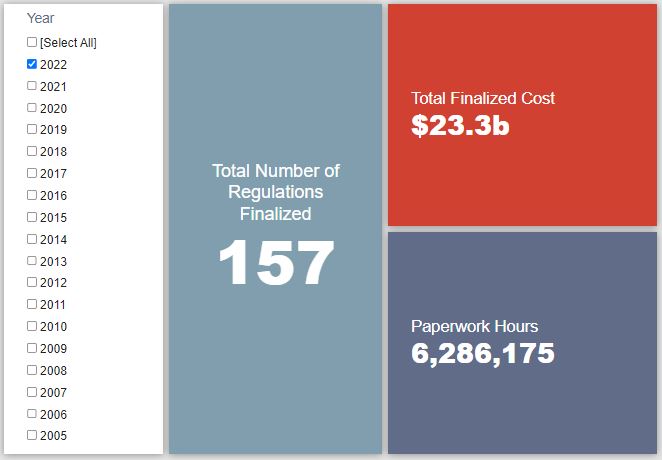Week in Regulation
September 6, 2022
DACA Becomes Final
While it was hardly all that voluminous, this past week’s set of rulemakings packed a punch. There were only six rulemakings with some measurable economic impact. Among that half-dozen, however, was the final version of the Department of Homeland Security’s (DHS) rule formally enshrining the Deferred Action for Childhood Arrivals (DACA) program. Across all rulemakings, agencies published $10 billion in total net costs and added 407,629 annual paperwork burden hours.
REGULATORY TOPLINES
- Proposed Rules: 27
- Final Rules: 74
- 2022 Total Pages: 54,209
- 2022 Final Rule Costs: $23.3 billion
- 2022 Proposed Rule Costs: $88.8 billion
NOTABLE REGULATORY ACTIONS
The most consequential rulemaking of the week was the DHS rule regarding “Deferred Action for Childhood Arrivals.” As noted in its proposed rule iteration published roughly 11 months prior, this marks the culmination of the Biden Administration’s goal to establish DACA as formal regulatory code, rather than its original, legally tenuous form as an enforcement memorandum. While the final version includes a handful of changes to the proposed version, they largely amount to clarifying issues raised by public comments. As such, the cost-benefit analysis maintains a similar structure, albeit with somewhat updated figures. DHS now estimates that the annualized costs for affected individuals and employers now amount to $480 million, or roughly $9.4 billion in total present value.
TRACKING THE ADMINISTRATIONS
As we have already seen from executive orders and memos, the Biden Administration will surely provide plenty of contrasts with the Trump Administration on the regulatory front. And while there is a general expectation that the current administration will seek to broadly restore Obama-esque regulatory actions, there will also be areas where it charts its own course. Since the AAF RegRodeo data extend back to 2005, it is possible to provide weekly updates on how the top-level trends of President Biden’s regulatory record track with those of his two most recent predecessors. The following table provides the cumulative totals of final rules containing some quantified economic impact from each administration through this point in their respective terms.
![]()
With the DACA rule discussed above, the Biden Administration saw – by far – the largest shift in its final rule total. The Biden total cost tally now leads even the Obama-era total (through the end of August 2010) by roughly $50 billion. There was virtually no change in the Obama Administration’s totals. Meanwhile, the end of August 2018 saw Trump-era costs and paperwork increase by $143 million and roughly 783,000 hours, respectively. Despite these increases, however, the overall Trump totals remain on the net-savings side of the ledger.
THIS WEEK’S REGULATORY PICTURE
This week, the Environmental Protection Agency (EPA) puts 15 states on notice about haze.
 Source: “The Haze” by SierraJansen
Source: “The Haze” by SierraJansen
On August 30, EPA published a notice in the Federal Register that it was formally finding that 15 states had failed to submit (and receive approval for) their State Implementation Plans (SIPs) regarding regional haze.
Under the Clean Air Act (CAA), states are responsible for implementing a federal program protecting visibility in “Class I Federal areas,” known as the Regional Haze Rule. By statute, there are 156 such areas, which include national parks and wilderness areas over certain sizes.
States comply by developing their own SIP that is reviewed by EPA. If a SIP is approved by EPA, then a state can implement it. If a SIP is not approved by a certain time for each 10-15 year planning cycle, then EPA starts a two-year clock whereby a state must get its SIP in order or be subject to a Federal Implementation Plan of EPA’s design.
The latest notice alerts 15 states – Alabama, Illinois, Iowa, Kentucky, Louisiana, Maine, Minnesota, Mississippi, Missouri, Nebraska, New Mexico, Pennsylvania, Rhode Island, Vermont, and Virginia – that they are now officially in the two-year window. Despite the notices, however, EPA said that it “intends to continue to work with states subject to these findings to assist them in developing approvable SIP submittals in a timely manner.”
The states listed above have until July 31, 2024, to have their SIPs approved.
TOTAL BURDENS
Since January 1, the federal government has published $112.1 billion in total net costs (with $23.3 billion in new costs from finalized rules) and 87 million hours of net annual paperwork burden increases (with 6.3 million hours in increases from final rules).












